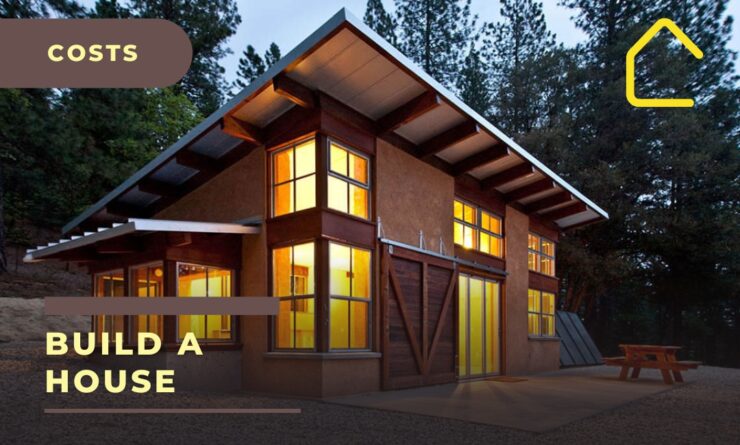Dreaming of crafting your very own sanctuary? Imagine a place where every nook and cranny echoes your personality, where every corner holds a story only you can tell.
Home isn’t just a place—it’s where our heart’s most cherished tales unfold.
But, as with all things bespoke, there’s a price to pay. So, what’s the golden ticket to constructing your dream abode in today’s world? Let’s dive deep and see if your pockets can match your dreams!
Crafting Your Dream Home: What’s the Price Tag?
Ever wondered about the golden number behind constructing your dream dwelling? On average, building a house will set you back a cool $485,000. This figure isn’t plucked from thin air; it’s based on a 2,600-square-foot, single-family home, as revealed by a 2020 study from the National Association of Home Builders.
However, remember, every dream is unique. Your final bill will dance to the tunes of various factors: the grandeur of your vision, the land you choose, the craftsmen you hire, the materials that catch your eye, and the ever-fluctuating real estate market. So, while it’s tricky to pinpoint an exact figure that fits all, let’s embark on a journey to decode the potential expenses that await you.
Cost to Build a House by Size
The average cost to build a house by size is about $150 per square foot. Here’s how that plays out for different home sizes:
| Square Feet | Cost to Build |
| 1,000 | $100,000–200,000 |
| 1,500 | $150,000–300,000 |
| 2,000 | $200,000–400,000 |
| 2,500 | $250,000–500,000 |
| 3,000 | $300,000–600,000 |
You can see now why tiny homes are so popular! But before you jump on that bandwagon, think realistically about how much space you need and if u need a second story, or a sunroom. You don’t want to cram your family into a house that’s way too small, and you also don’t want to waste money on space you don’t need.
Cost to Build a House by State
How much it costs to build a house also depends on where you build it. Here’s a look at the average cost to build a 2,000-square-foot home in each state:
| State | Cost to Build a House |
| Alabama | $268,000 |
| Alaska | $421,000 |
| Arizona | $296,000 |
| Arkansas | $252,000 |
| California | $405,000 |
| Colorado | $299,000 |
| Connecticut | $345,000 |
| Delaware | $327,000 |
| Florida | $264,000 |
| Georgia | $274,000 |
| Hawaii | $413,000 |
| Idaho | $316,000 |
| Illinois | $265,000 |
| Indiana | $219,000 |
| Iowa | $214,000 |
| Kansas | $207,000 |
| Kentucky | $281,000 |
| Louisiana | $270,000 |
| Maine | $282,000 |
| Maryland | $294,000 |
| Massachusetts | $351,000 |
| Michigan | $217,000 |
| Minnesota | $237,000 |
| Mississippi | $255,000 |
| Missouri | $227,000 |
| Montana | $299,000 |
| Nebraska | $211,000 |
| Nevada | $334,000 |
| New Hampshire | $300,000 |
| New Jersey | $377,000 |
| New Mexico | $291,000 |
| New York | $360,000 |
| North Carolina | $302,000 |
| North Dakota | $213,000 |
| Ohio | $222,000 |
| Oklahoma | $261,000 |
| Oregon | $341,000 |
| Pennsylvania | $302,000 |
| Rhode Island | $338,000 |
| South Carolina | $302,000 |
| South Dakota | $204,000 |
| Tennessee | $262,000 |
| Texas | $264,000 |
| Utah | $289,000 |
| Vermont | $308,000 |
| Virginia | $310,000 |
| Washington | $343,000 |
| West Virginia | $301,000 |
| Wisconsin | $239,000 |
| Wyoming | $290,000 |
Housing isn’t the only cost that varies from state to state. Other costs—like groceries, transportation and health care—will also depend on which state you call home.
Home-Building Cost Estimator
In this section, we’ll go over the major components of building a home and take a look at how much it costs to get each job done, on average.
Keep in mind that each of the following numbers are based on the average price for that step of the process, so the numbers may wind up looking a little different for you. Ultimately, your budget is what will dictate how much you spend on each of these areas (more on the budget a little later).
1. General Building Expenses: $98,000
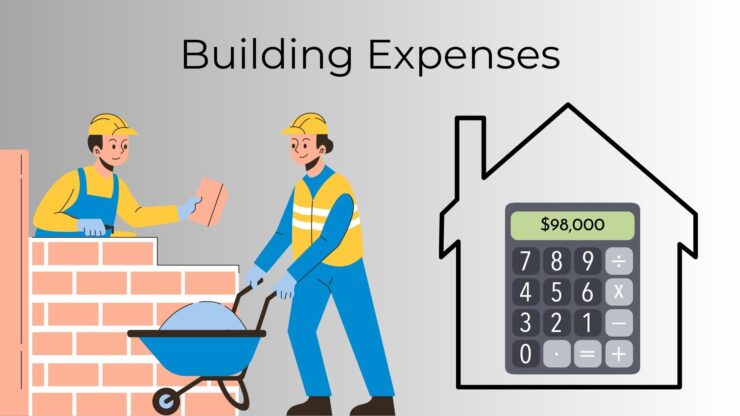
Building a home isn’t just about bricks and mortar; it’s also a business venture. When you hire a builder, you’re not just paying for the walls and roof.
There’s the overhead to consider, marketing expenses, and of course, their profit margin. After all, they’re not just building out of the goodness of their hearts. These costs can skyrocket, often reaching a whopping six figures.
2. Securing Your Spot: Finished Lot at $90,000
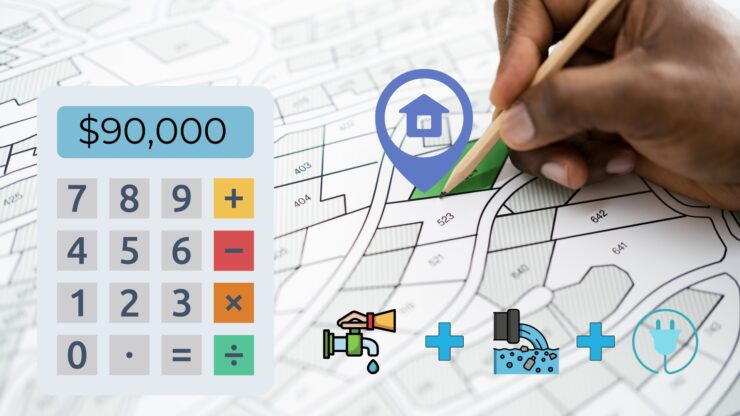
Picture this: A plot of land, ready with all the essentials – water lines, electric connections, and a sewage system. This is what a finished lot offers. On average, securing such a lot will cost you about $90,000.
Sure, you could opt for an undeveloped property, which might be lighter on the pocket initially. But remember, setting up utilities later can be a financial curveball you didn’t see coming.
3. Site Work: The Foundation at $18,000
The term ‘site work’ might sound vague, but it’s where the magic begins. It encompasses:
- Blueprints of Your Dream: Before a single brick is laid, you need a plan. An architect or draftsperson will sketch out every intricate detail of your home, from its layout to the electrical wirings. This is the roadmap to your dream dwelling.
- Legalities and Paperwork: Once your plans are ready, there’s a maze of permits and inspections to navigate. These are non-negotiable and ensure your home is up to code. Just obtaining a building permit can set you back by $5,000. And don’t forget the $4,000 for water and sewer inspections.
- A Nod from Uncle Sam: The government has its hand out too, expecting nearly $4,000 in impact fees. This contribution ensures your community thrives, funding roads, parks, and water treatments..
4. Laying the Groundwork: Foundation at $35,000
The foundation is the unsung hero of your home. It’s the bedrock upon which everything else stands. Typically made of sturdy lumber and concrete, the foundation ensures your home remains steady and strong.
If you’re dreaming of a basement, be prepared to shell out a bit more. And if your plot is on uneven terrain, retaining walls might be essential to prevent soil erosion, ensuring your foundation remains unshaken.
5. The Skeleton: Home Framing at $52,000
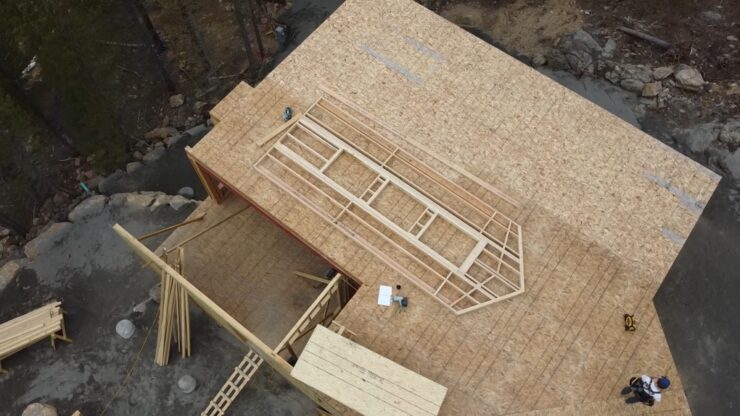
Hold onto your hats, because this is where the magic happens! The frame is the backbone of your home, and it’s also one of the heftiest expenses you’ll encounter. As the lumber stacks up, forming the walls and roof, you’ll see your dream home materializing. The basic frame can cost upwards of $41,000.
But wait, there’s more! If trusses (those nifty triangular supports for your roof) aren’t part of the deal, they’ll add roughly $6,000. And once this skeletal structure is up, it needs protection.
Enter sheathing, a protective layer that’s like the skin for your home’s bones, costing around $3,000. Opt for metal or steel reinforcements, and you’re looking at an additional $2,000.
6. Dressing Up Your Home: Exterior Finishes at $42,000

The exterior isn’t just about curb appeal; it’s the protective shield for your home. Covering the entire perimeter, the exterior walls alone can cost a cool $19,000.
But a house isn’t just walls. It’s the welcoming doorway, the windows that let in sunlight, and the garage that houses your prized possessions. These essential features will set you back about $12,000. And let’s not forget the crowning glory: the roof finishes, which come in at an additional $10,000.
Building a home is like crafting a masterpiece, with each element playing a crucial role. And while the costs might seem daunting, remember: you’re investing in a space that’s uniquely yours.
7. Interior Finishes: $75,000
Get out your wallet! Besides the cost of the finished lot, the interior is usually the most expensive part of the cost to build a house. There are a lot of expenses to cover, so let’s break it down in a chart.
| Cabinets and countertops | $14,000 |
| Flooring | $12,000 |
| Doors, trims and mirrors | $11,000 |
| Drywall installation | $11,000 |
| Painting | $8,000 |
| Insulation | $5,000 |
| Appliances | $5,000 |
| Plumbing fixtures | $4,000 |
| Lighting | $3,000 |
| Fireplace | $2,000 |
| Total | $75,000 |
8. Major Systems Installation at $44,000
The major systems of your home are its lifelines, ensuring comfort and functionality. This includes the intricate plumbing for your morning showers, the HVAC to keep you cozy, and the electricity that powers your daily life.
Cutting corners here isn’t advisable unless you fancy a house without modern conveniences like indoor plumbing. And remember, this cost doesn’t cover the actual fixtures like sinks or lights; those come under interior finishes.
9. The Home Stretch: Final Steps at $20,000
You’re on the brink of realizing your dream! The last leg of your home-building journey involves the outdoor aesthetics and functionality.
This includes landscaping to give your home a lush embrace, a driveway to welcome you home, and perhaps a porch or patio for those leisurely evenings. And after all the hustle and bustle, a thorough cleanup is essential, which might lighten your wallet by about $3,000.
10. The Unexpected and Overlooked: Miscellaneous at $11,000
Life is full of surprises, and so is the process of building a home. On average, homeowners spend around $11,000 on aspects that don’t neatly fit into the predefined categories. It’s always wise to have a buffer for those unforeseen expenses or the little extras that might crop up along the way.
Can You Afford To Build a House?
So, you’ve got the blueprint of your dream home and a ballpark figure of the costs. But the million-dollar question (or perhaps a few hundred thousand) is: Can your wallet handle it?
Crunching the Numbers
To gauge if you’re financially ready, consider this golden rule: Your monthly payment for a 15-year fixed-rate mortgage, inclusive of homeowners insurance, property taxes, and any HOA fees, should not exceed 25% of your monthly take-home salary. And that’s after making a down payment of at least 5-10%. Though, aiming for a 20% down payment is the sweet spot.
Why the 15-Year Fixed-Rate Mortgage?
If the 15-year fixed mortgage payment gobbles up more than a quarter of your salary, it’s time to either increase your down payment or rethink your home aspirations. You might wonder, why not opt for a 30-year mortgage? Simply put, it’s a financial trap. It not only binds you to an extended payment period but also siphons off a significant amount in interest. No dream home is worth that financial strain!
The Bigger Picture
Dedicating more than 25% of your income to your home can jeopardize your other financial aspirations. Think about your retirement nest egg or your child’s college fund. Moreover, diving into homeownership without being debt-free and without a safety net (an emergency fund covering 3-6 months of expenses) is akin to sailing stormy seas without a lifejacket.
In essence, while the allure of a custom-built home is undeniable, it’s crucial to ensure you’re on solid financial ground. After all, a dream home should be a place of comfort, not a source of financial stress.
How to Build Your Own House
So, you’ve crunched the numbers and decided that building a house is the direction you want to go. That’s super exciting! But before Bob the Builder and his talking construction equipment get involved, you need to know how to build your own house.
No, you won’t have to grab a drill or a hammer and climb up on the roof. There are, though, some steps you’ll need to take if you want the home-building process to go smoothly. Here’s a look at the four most important steps.
1. Partner with a Real Estate Pro:
Embarking on the home-building journey without a real estate agent is like setting sail without a compass. An experienced buyer’s agent is your advocate, guiding you from land acquisition to the day you step into your completed home. They bridge the communication gap between you, the builder, and the architect, ensuring your vision is realized.
Wondering where to find such a gem? Our Endorsed Local Providers (ELP) program is your treasure trove. With a curated list of RamseyTrusted agents in your vicinity, you’re guaranteed a seamless experience. They might not make it as simple as whipping up a sandwich, but they’ll definitely make the process more palatable!
2. Chart Out Your Financial Plan:
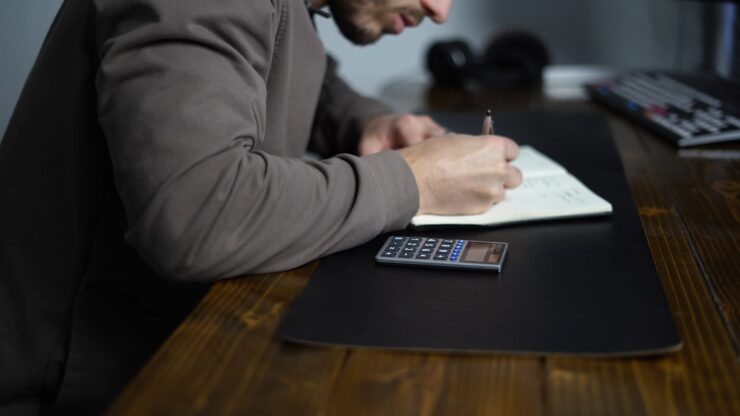
Before the first brick is laid, your finances need a solid foundation. Draft a meticulous budget for your project, just as you would for your household or business.
Determine your spending limit, keeping in mind that your monthly house payment shouldn’t exceed 25% of your net income. With your agent’s insights, allocate funds for each phase of construction. And once your budget is set, treat it as sacred. Deviating from it could transform your dream project into a financial quagmire.
3. Design Your Dream:
The blueprint is where your dream takes shape. It’s the canvas where you decide the number of rooms, the placement of windows, and every intricate detail of your home. Engage an architect or a draftsman to sketch your vision.
A pro-tip: opting for a draftsman can be a cost-effective alternative to an architect. Ensure they collaborate with your builder to avoid designing elements that stretch beyond your budget.
Once your blueprint is finalized, resist the temptation to make frequent changes. Occasional tweaks are manageable, but constant alterations can derail your budget and timeline.
4. Crafting a Precise Timeline:
Building a house isn’t just about bricks and beams; it’s about precision and timing. Think of your construction project as a symphony, where every instrument (or task) must play its part at the right moment.
How intricate should your timeline be? Imagine knowing when the first brush stroke of paint will be applied or when the final shrub will be planted.
By scheduling tasks like the arrival of the trim carpenter, painters, roofers, and landscapers, you ensure a seamless flow of work. This proactive approach also shields you from potential labor shortages.
Regular check-ins with your builder and agent are crucial. Consider setting up weekly meetings to review the schedule, blueprint, and budget, ensuring everyone is in harmony.
FAQ
How much does it cost to build a mansion?
The cost to build a mansion can range from $1 million to $10 million or more, depending on the size, location, materials, and luxury features included.
How much does it cost to build a 2000 sq ft house in Texas?
The cost to build a 2000 sq ft house in Texas can range from $160,000 to $400,000, depending on whether it’s a modular or stick-built home and the level of customization.
How much does it cost to build a 3000 sq ft house in Texas?
The cost to build a 3000 sq ft house in Texas can range from $240,000 to $600,000, depending on the type of construction and customizations.
How much would it cost to build a castle like Hogwarts?
Building a castle like Hogwarts would cost hundreds of millions or even billions of dollars. The exact cost would depend on the size, location, materials, and level of detail and craftsmanship involved.
How big is a McMansion?
A McMansion typically refers to a large, modern house that is considered oversized for its parcel of land or its neighborhood. They can range from 3,000 to 5,000 square feet or more.
Can I build my own house in Texas?
Yes, you can build your own house in Texas. However, you’ll need to comply with local building codes and regulations, obtain necessary permits, and ensure that the construction meets safety standards.
How much does it cost to build a house in Florida?
The cost to build a house in Florida can vary widely based on location, size, and materials. On average, it can range from $100 to $200 per square foot, but this can be higher in sought-after locations or for luxury homes.
The Grand Finale: Moving into Your Dream Home
The crescendo of your home-building journey is finally moving in! Given that building a home typically takes less than a year, it’s never too early to strategize your move.
Relocating can be daunting, but the right partners can make it a breeze. Enter PODS Moving & Storage. They simplify the process by delivering a storage container to your current residence, allowing you to pack at your own pace.
Once you’re ready, they’ll transport your belongings straight to your new abode. No more last-minute scrambles or trying to fit your budding musician’s drum set into the back of your car!
Building and moving into a house is a monumental task, but with meticulous planning and the right partners, it becomes a memorable adventure. Here’s to new beginnings in a place you can truly call home!

